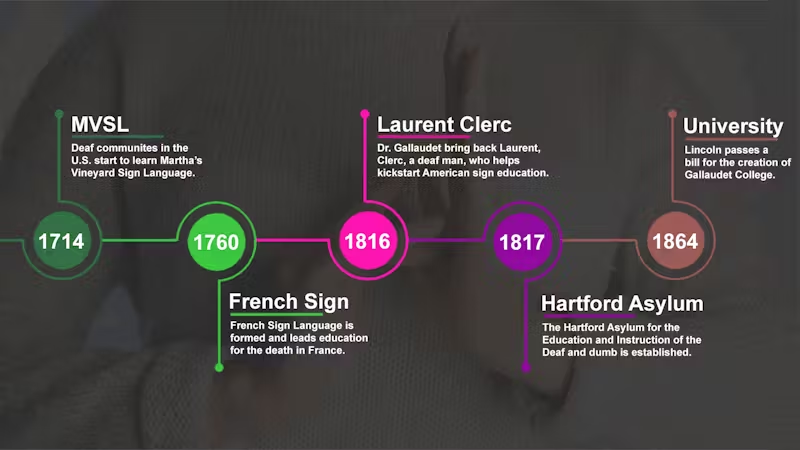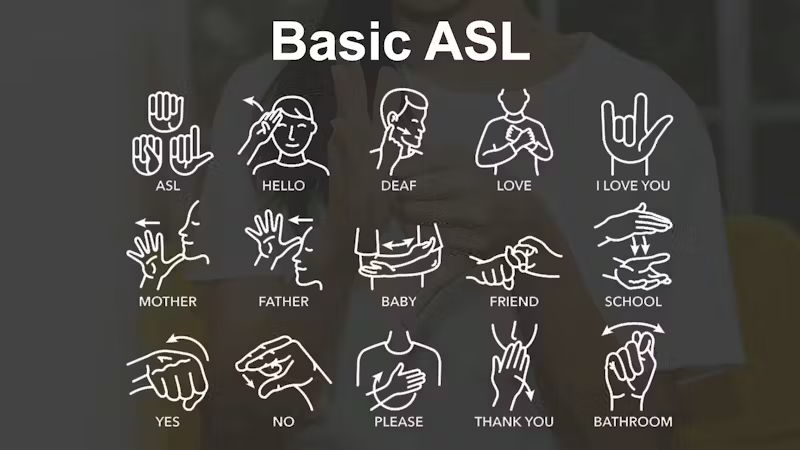The Birth Of American Sign Language
Author: Sam Walker-Smart
Last update: 3/3/2023

Introduction
With an estimated 250,000–500,000 speakers, American Sign Language (ASL) is the chosen language for the deaf community within the United States. Also used in Canada, Southeast Asia, and West Africa, the history of ASL, like any language, is a fascinating one. A combination of older forms as well as local color, this liberating language boasts an inspirational, 200-year-long history filled with collaboration, kindness, and the power of education. American Sign Language (or simply ASL) is now more prevalent than ever. It's a familiar sight on our screens thanks to the 21st Century Communications and Video Accessibility Act, and it's even used to enhance concerts and festivals. Let us take you back to its origins and show how ASL became the institution it is today.
How ASL Was Born
The roots of American Sign Language date back to the early 1800s, specifically with a man named Dr. Thomas Hopkins Gallaudet. In these early years, there was no standardization of sign language, and the few communities of deaf people that did exist only had very basic signs used for communication. In 1814, Dr. Gallaudet, a local minister from Connecticut at the time, noticed that his neighbor's daughter, Alice, despite not being able to hear or speak, was very intelligent. Dr. Gallaudet tried to educate the young girl but didn't know how to communicate correctly with her, so with some community funding, he traveled to Europe.
Once arriving in France, Dr. Gallaudet met with Abbe Sicard, Jean Massieu, and Laurent Clerc. These three had developed and pioneered French Sign Language, which had been leading education for the deaf since 1760. After much education, senior instructor Laurent Clerc traveled back to the United States with Dr. Gallaudet to help establish The American School for the Deaf. Opened in 1817, this free public deaf school would spawn the first American sign language.
As new signs were created from the pre-existing deaf communities, French signs were taught by Laurent Clerc to fill the gaps. Over the years, the two men helped train thousands of deaf people to communicate through sign language, and by 1863, twenty-two deaf schools in the U.S. had been established, most of which had been founded by former students of Clerc and Dr. Gallaudet. The following year saw President Lincoln passing an act allowing for the formation of Gallaudet University, which still remains the world’s only liberal arts university for the deaf.
Following the establishment of Gallaudet University and the creation of ASL, more and more milestones were hit by the American deaf and hard of hearing community. Take a look at our history chart of American Sign Language:
Progression Of Sign Around The World
Now that we've familiarized ourselves with the history of ASL, where did sign language begin? This is a bit of a tricky question to answer. Many scientists agree that prehistoric man used to communicate through grunts and physical movements, but we have no conclusive proof of that. The first recorded evidence of a deaf person trying to sign comes from Ancient Greece. Plato recorded something Socrates once said, "If we had neither voice nor tongue, and yet wished to manifest things to one another, should we not, like those which are at present mute, endeavor to signify our meaning by our hands, head, and other parts of the body?”
With the birth of French and American Sign Language, countries around the world started to create and adapt their own variations. However, this transition from strictly oral teaching to sign inclusivity didn't come with ease. In 1880, the infamous Milan conference saw the ban of all deaf educators in Italy, and by 1920, nearly 80% of all deaf programs worldwide were using oral methods rather than Sign. Luckily, with time eventually comes progression, and with brilliant minds like William Stokoe, sign language found its resurgence in the 1960s.
Thanks to Stokoe and numerous deaf educators worldwide, American Sign Language and many other national sign languages are not just recognized as tools for the deaf and hard of hearing; they are considered official languages. Despite all this, sign language is still not recognized in many places in the world. The fight for deaf and hard of hearing education grew in the 70's and has continued into the modern era of sign language.
Sign In The Modern Era
The past half-century has seen much progress not only for ASL but also for inclusive education, public awareness, and legal empowerment for various disabilities. In 1973, the Rehabilitation Act was signed, prohibiting discrimination based on disability in programs conducted by federal agencies. This was followed in 1990 by the Americans with Disabilities Act, finally bringing into law that discrimination based on disability is an offense.
Nowadays, thanks to the rise of digital technologies, anyone with a smartphone can learn ASL if they are interested. Apps such as ASL Coach, ASL: Fingerspelling, and Marlee Signs offer both students and teachers interactive means to study. Interpreters now accompany Presidential addresses, and globally an increasing number of both news and regular TV shows are supported by sign language practitioners. Dedicated and seriously impressive ASL pros have gone viral for accompanying rap superstars like Kendrick Lamar and some of the heaviest bands on the planet (NSFW).
Examples Of Sign Language
Now that we’ve explored the birth of ASL, and how it’s used in the modern world, let’s take a look at some basic signing. Although there is no international sign language, just as there is no international spoken language, there are a few signs that are widely understood across the world, and particularly in the West. Here are a few of those key signs and the corresponding words for them:
The evolution of ASL and the manner in which it's been adopted into wider society is a testament to the modern educational system and the leaps and bounds society has made into being a more inclusive place. It's truly the story of how one man's kindness and curiosity helped change not only the lives of millions over the years but also the world as a whole.
American Sign Language Learning Resources
If this article has inspired you to learn more about sign language, and possibly even learn it yourself, then we have a few incredibly useful resources for you. Take a look at the links below and you’ll be well on your way to sign language proficiency.
- Lifeprint.com - First 100 Signs - This site, along with a great YouTube video, help teach you the first 100 most common signs.
https://www.lifeprint.com/asl101/pages-layout/concepts.htm - Schoolofsignlanguage.com - Learn Sign - Improve your sign comprehension with easy tutorials and videos.
http://www.schoolofsignlanguage.com/learn-online/learn-online-free-only/ - Signlanguage101.com - Sign Course - This site offers in-depth courses and high-quality video lessons.
https://www.signlanguage101.com/ - Gallaudet.edu - ASL For Free - Online tutorials and a really intuitive ASL Connect service.
https://www.gallaudet.edu/asl-connect/asl-for-free - Handspeak.com - A site built for learning with flashcards, quizzes, and even trivia.
https://www.handspeak.com/ - Signedwithheart - YouTube Channel - Teaching sign language through social media in a fun and easy way.
https://www.youtube.com/channel/UCZrcp5LyFbqp_jIhCKakTKg/featured - Hand On ASL - Application - The perfect on-the-go app to learn and develop your sign language.
https://apps.apple.com/us/app/hands-on-asl/id1450898947
Sources
- 21st Century Communications and Video Accessibility Act (CVAA)
https://www.fcc.gov/consumers/guides/21st-century-communications-and-video-accessibility-act-cvaa - Inside the World of Concert Sign Language Interpreters
https://www.vice.com/en/article/3bd35y/inside-the-world-of-concert-sign-language-interpreters - Birth of ASL & Dr. Gallaudet
https://www.startasl.com/history-of-american-sign-language/ - French Sign Language & Laurent Clerc
https://www.britannica.com/topic/American-Sign-Language - Formation Of Gallaudet University
https://projects.iq.harvard.edu/asl/deaf-history-timeline - Early Sign Language
https://aslblog.goreact.com/2017/04/19/the-history-of-sign-language/ - The Work Of William Stokoe
http://gupress.gallaudet.edu/stokoe.html - Ted Talk: How Sign Language Can Bring Music To Life
https://www.youtube.com/watch?v=dkfCD7c2HcQ&ab_channel=TEDMED

